John May was a Yeoman Warder at the Tower of London from 21st May 1827 replacing Stephen Claddis, to his death on the 23rd October 1855, and he was replaced by Henry Hughes (61), some 28 years as a Yeoman Warder.
It may be worth remembering that
When Sir Arthur Wellesley The Duke of Wellington had become the Constable of the Tower of London on the 5th February 1827, his aim was to make the Tower a Military Barracks, so he immediately took about the re militarising by clearing buildings, he closed all the taverns, in favour of an Army Canteen, drained the moat, moved the Royal Menagerie (London ZOO) to Regents Park.
The Yeoman Warders were also on his list for refurbishment. At that time, Warders would buy and sell their Wardership’s for around £250.00 guineas, which meant that you often not get the best person for the job.
The practice of purchasing a position sounds strange now, but was common practice within the Army. Officers could purchase a commissions in the Cavalry or Infantry, a practice started during the reign of Charles II about 1683, although it was already in practice at the Tower of London. A Wardership could be purchased from the Lieutenant of the Tower, although this was stopped by Royal command 10th July 1688, and so on retirement Warders would put their position and sell it directly to their replacement, as long as the Tower authorities were happy with the new comer. The money received was the outgoing Warders retirement fund.
The money paid was a cash bond that would be forfeit in the event of gross misconduct, cowardice, or desertion, the term “cashiered by the crown” is still one used for a loss of commission, the practice was halted in the Army as part of the Cardwell Reforms on the Military on the 1st November 1871, and ended here by the Tower by the Duke of Wellington in 1827.
So John was born in 1787 in Puxton, in the parish of Congresbury Somerset, and christened 1 October 1787, in Puxto, his father Thomas and Mother Hannah, he also has a sister Ann.
In early 1803 aged 16 he joins the local Militaria, then on the 9th January 1805 he enlists in the 1st Regiment of Foot Guards (which became the Grenadier Guards), at Bath Somerset (aged 18). At that time the Field Marshall Sir Arthur Wollesy, The Dukes of Wellington was the Colonel of the Regiment, and it looks like he had some influence on John Mays later career.
On enlisting in the 1st Regiment of Foot Guards, John had a meteoric rise through the ranks, he spent 122 days (4 months) as a private, and then promoted to Corporal 4 years 20 days, then promoted to sergeant, and he was sergeant for nearly 11 years then a Sergeant Major for 7 years 66 days.
As a sergeant he fought in the battle of Waterloo, with the 3rd Battalion, in Lieutenant Colonel The Hon. H. P. Townshend’s Company. He would have also seen action at Qutra Bra.
He was discharged on the 25 June 1827 having served 22 years 183 days, with 2 years added for service at Waterloo, so he served a total of 24 Years 183 days.
On discharge John had 2 medals, Waterloo, and the (Peninsular Medal) General Service Medal with Clasps for Nivelle and Nive, these Medals are reflected in the Tower records, John was also part of the occupation of Paris as was Yeoman Warder James Draffin (30) , YW John Lund (6) and YW George Townsend (46), all in the 3rd Bn 1st Regiment of Foot Guards.
The Duke of Wellington obviously had his eye on John and on retirement from the Army he became a Yeoman Warder at the Tower, on the 21 May 1827. It was common practice for Yeoman Warders to be appointed while still in Military service.

Fig 2: Extract from Tower records shows John becoming a YW on the 21 May 1827. The edit 28 5/12 was added by CYW Cook in the 1950s and is incorrect
His military records and discharge documents all reflect that John May had completed 24 Years, those who fought in the Battle of Waterloo were give 2 years extra service and pay, which would count towards their seniority and pension, they were known as “Waterloo Men”.
On figure 1 someone has numbered in 28 5/12, which is incorrect.
On Figure 1 John May is YW 457 and on Figure 2 he is 517, in around 1890, it was decided that John would be renumbered as 1 and all subsequent Warders numbered from him. The Duke of Wellington had some hand in John recruitment, and made it obvious the buying and selling of position had now stopped
Extract from Wellingtons Letters
12 June 1827 (127-404)
“The Duke of Wellington proposed to appoint Serjeant Major of the Grenadier Guards John May, to be a Yeoman Warder of the Tower, and he shall also have the house left vacant by the death of Claddis (Salt Tower). The Duke says that May shall not be called upon to pay the Constables fee of Two Hundred and Fifty Guinea’s, but will pay the minor fees amounting, I believe to £24, 6, 0.
You will make May to understand when he is sworn a Warder, that if hereafter the `Constable should regulate the office and should throw upon the Warders any duty in addition to what is now required of them. His Grace fully expects that May would consider himself bounded by such regulation and would perform such additional duty without demanding any further remuneration”.
Signed: Fitzroy Somerseh
When John May took the position as Yeoman Warder they would still have worn the red Tudor designed Tunic and the Tudor Bonnet, as every day wear, as the Blue Undress Uniform was not introduced until 1858, the Blue undress hat in 1878.
On appointment John was allocated the Salt Tower, although to live in although it’s not clear if his family moved in with him.
A the time John became a Warder in the Tower law enforcement in England was administered at a local level, with a locally maintained system of Watchmen and volunteers, paid and unpaid Constables and when things became problematic, the Army or more likely a local militaria unit would get involved, which was not ideal they were heavy handed and trained to use lethal weapons, with lethal force.
Local people would have to do a sort of nation service, serving as Watchmen or Militaria, there was an opt out on payment of a fine, which Warders were exempt.
With England’s industrialisation the population of London and other cities in England ballooned, and these local systems were completely inadequate, and so Sir Robert Peel proposed a profession police force, starting with London, a Metropolitan Police Force.
At the time Duke of Wellington became the Constable at the tower , he was also the prime minister, and Sir Robert Peel home secretary, from 1822 to 1830 (with a small break) Robert and the Duke worked well together, Robert who was widely perceived as the number-two in the Tory Party, after Wellington himself, (Ramsay, Sir Robert Peel by ramsay page 104).
Robert with the backing of Wellington, wanted to reform this localised law enforcement this with a professional group. So in 1829 the Metropolitan Police Act was passed and with that the Metropolitan Police were formed, the first of the new policemen took to the streets in September of 1829 based at Scotland Yard.
It might have been that The duke said I have a good man at the Tower to become a Superintendent, states that Robert Peel wished Superintendents to be replaced by promotion from police rising through the ranks rather than by ‘parachuting in’ commissioned army or navy officers.
Right at the start in September 1829 there would be no such police ‘other ranks’ to promote and so appointing a senior army NCO like May to be a Superintendent was probably a compromise solution. Again the Duke of Wellington may have had a hand in the recruitment of John May From the Tower records:
29 July 1829 (41)
I am desired by the Duke of Wellington to inform you that he has given Warder John May leave of absence in order that he may accept a situation offered to him under the new police regulations. Warder John May however it to he present at all the musters of the Warders in the tower whenever they are made his present leave extends to the next muster.
Signed E Drummond
John retained not only his job as a Warder but his house in the Salt Tower, this was not uncommon for Warders to have other jobs, a number of Warders took up positions away from the Tower, YW John Weatherhead 35 1844 to April 1882 was Chief Warder Newgate Prison and then Governor of Holloway Prison, and John Dwane (73) was the Barrack Sergeant Major (Regimental Quartermaster Sergeant) Milton Barracks, Gravesend.
Obviously John was called forward even before the act was passed to start organising the new police force:
John May was the first Yeoman Warder appointed to the Tower from the Military, (known as YW No. 1)and had fought at the Battle of Waterloo, in the 1 Regiment of Foot Guards (Grenadier Guards) and appointed as the first Superintendent of Police “A” division. Thomas Baker (Second Down) was the first Yeoman of the Guard (Known as YG No. 1) appointed from the Military, he also fought at the Battle of Waterloo in the Coldstream Guards, he was appointed the first Superintendent of Police “C” division
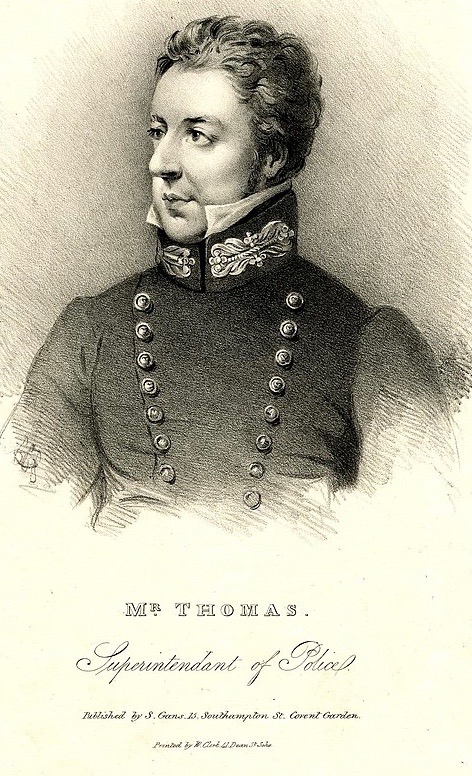
Joseph Saddle Thomas First Superintendent of “F” Division, Covent Garden. Wearing the same uniform as John May would wear.
So on the 31 July 1829 John May became the first Superintendent of “A” Division Metropolitan Police, which policed the Whitehall area of London. Since the divisional station house was adjacent to the offices of the Joint Commissioners, Sir Charles Rowan and Sir Richard Mayne, John May began to serve as unofficial second-in-command of the force, providing a link between the Commissioners and their men. It was he who interviewed the first candidates for the force, sifting them before Rowan and Mayne made their final selection.
The make up of the Offices No. 4 Whitehall Place
The junior clerks worked on the 1st. floor of No. 4 Whitehall Place whilst the Chief Clerk shared the 2nd. floor with the Receiver and his staff. Sir Richard Mayne had the 3rd. floor all to himself. The ground floor was occupied wholly by police – overseen by the Superintendent of A Division, John MAY.
This military background for the Met’s early senior officers was not unusual, giving experience not only of commanding of large organisations but also perhaps of what we would now call ‘public order duties’. Such duties had been within the Army’s remit before 1829 but would have played a major part in the life of the new Met’s A (Whitehall) Division.
Sir Robert Peel wished Superintendents to be replaced by promotion from police rising through the ranks rather than by ‘parachuting in’ commissioned Army or Navy officers. However, at the start in September 1829 there would be no such police ‘other ranks’ to promote and so appointing a senior army NCO like John May and Thomas Baker, to be a Superintendent was probably a compromise solution.
On the 30 October 1841 the Grand Storehouse at the Tower of London was destroyed by fire, the Tower is part of H divisions jurisdiction , although it looks like Superintendent John May was asked to help, perhaps local knowledge, as a Yeoman Warder.
After the fire a survey was carried out at the Tower in 1849 and John May is still shown as living in the Salt Tower, although he lives in 34 Dartmouth St, Westminster
Unfortunately, John health starts to deteriorate and in August 1855, he has asked someone else to do his duties.
On the 23 October 1855 John May passed away
John Mays Private Life
- Charles May Born 1818
- Thomas May Born 1819
- Edmund George Born 17 January 1821
- Eliza May Born 11 Jan 1823
- Alfred John Born 24 Feb 1824
Charlotte died abt 1824, and John remarry Phillis Eliza nee Baker (b 1807 Chatham, Kent – died 10th May 1897 in Paddington) on the 16th September 1834, they live 34 Dartmouth Street, just off Birdcage Walk in the parish of St Margaret’s from around 1830 to 1855. They have three sons and six daughters
- Augusta Maria Born 1835, in Westminster
- Emma Ellen Born 5 Jan 1837
- Louisa Ann Born 16 Oct 1838
- Frederick Albert Born 1840
- Eliza May Born 11 February 1823
- Alfred May born 1824 in Middlesex sometimes Alfred Innes May
- Adelaide Born 22 Feb 1842
- Janette Elizabeth Born 14 May 1845
- John Baker Born 28 July 1847
The children also have interesting lives:
Charles May was born 7th December 1819, while John was still serving in the Grenadier Guards based at Knightsbridge. Charles also joins the Metropolitan Police, on 7th November 1835, with his only referee stated as “Mr John May. Superintendent [sic]. A Division”(!).
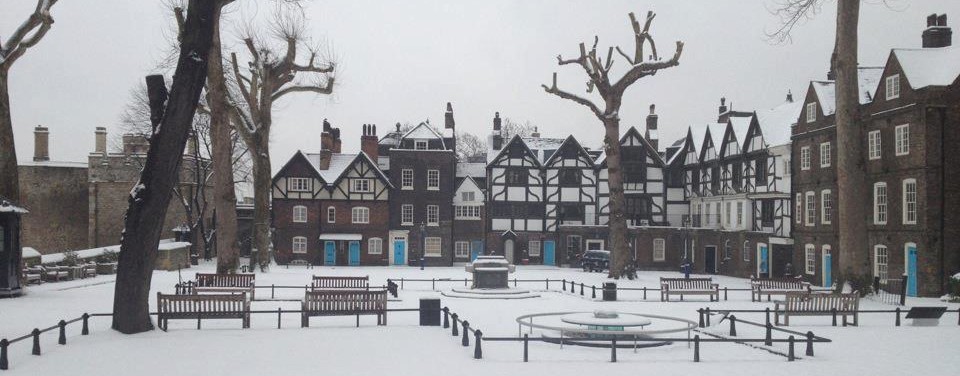



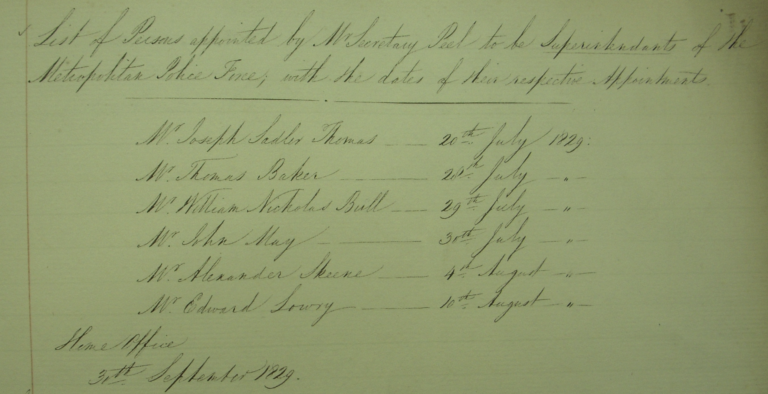
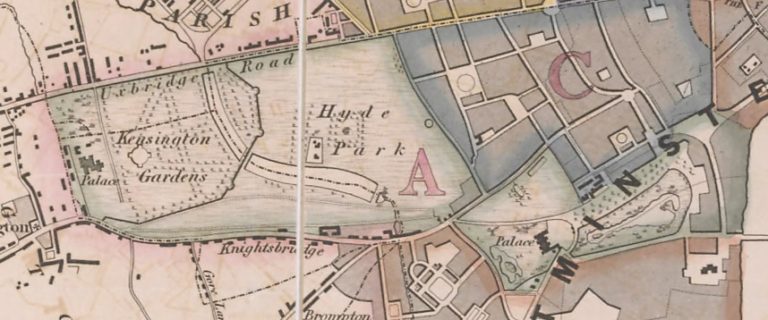

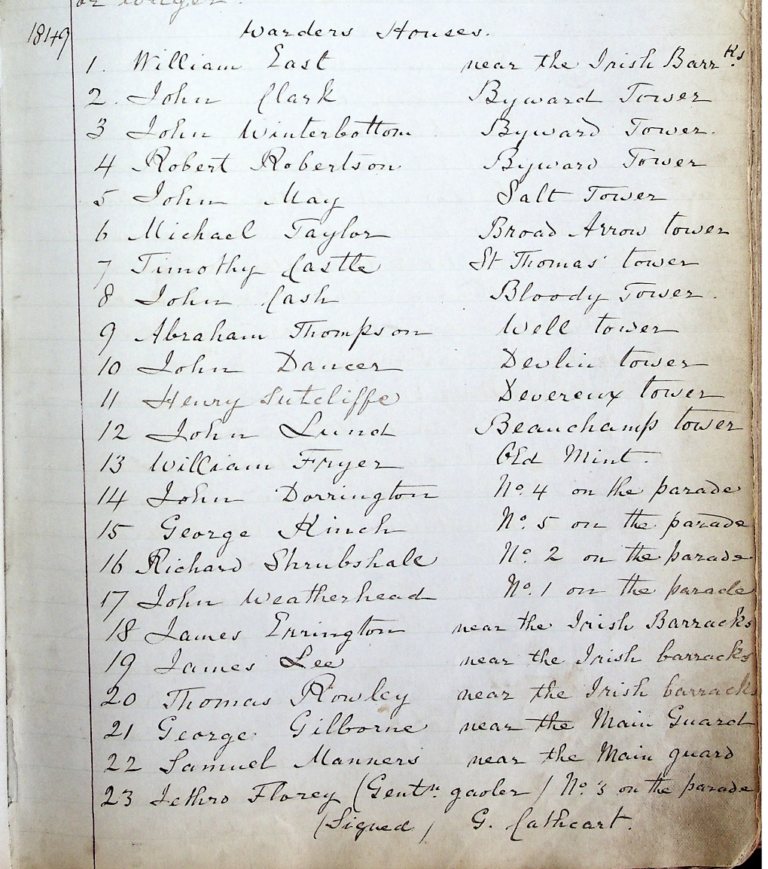


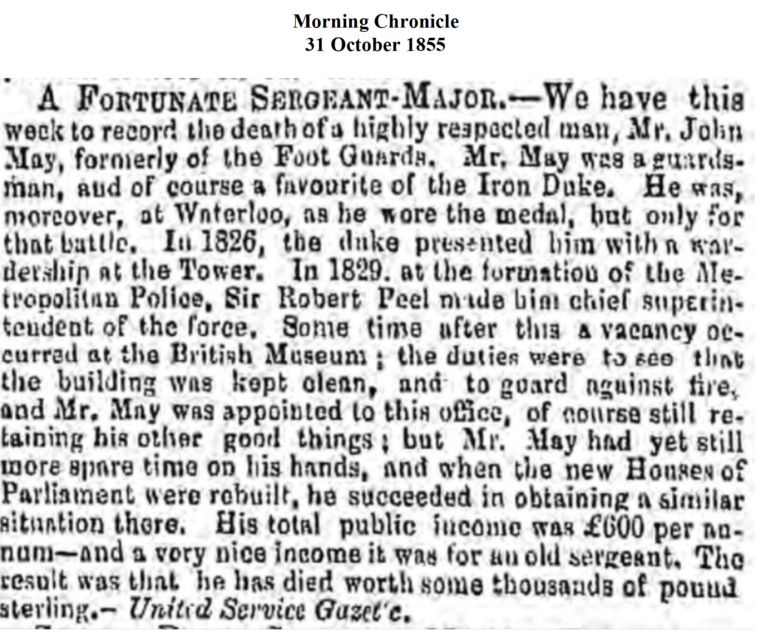


Leave a reply to Yeoman Warder John May